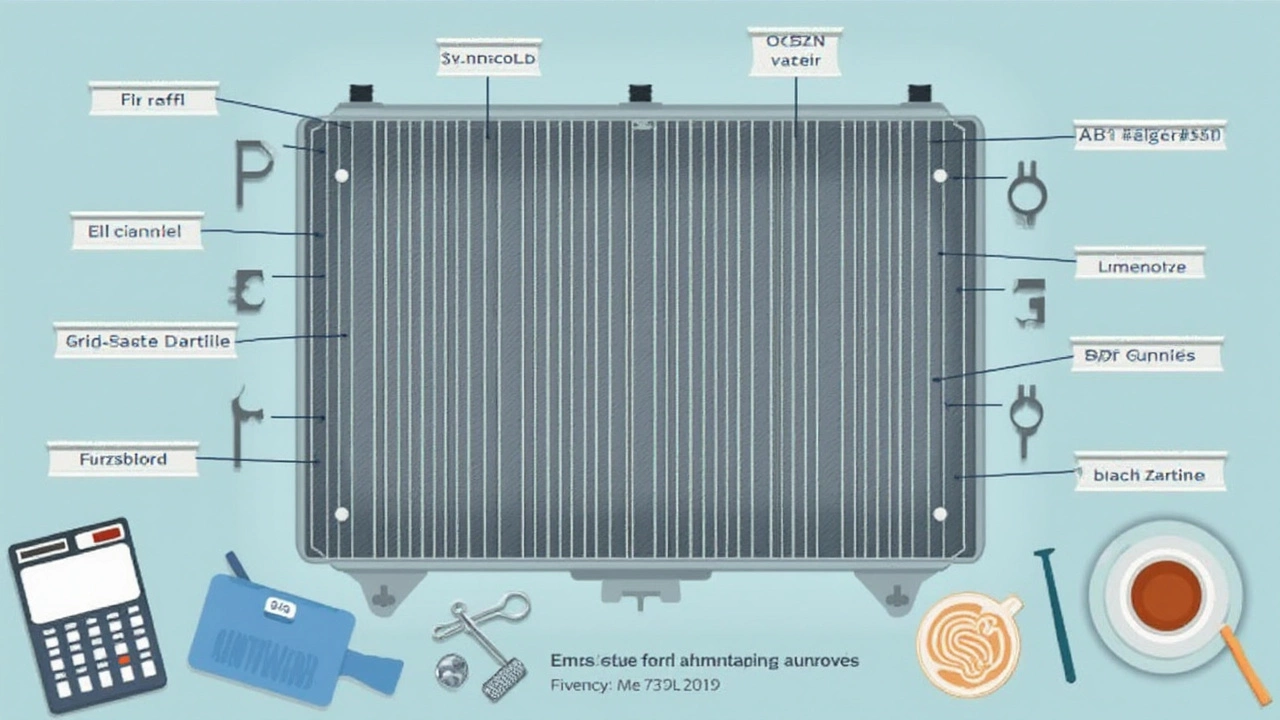Car overheating is the kind of problem you just can’t ignore. Most folks worry the minute steam creeps out from under the hood, and it’s usually the radiator’s fault. The big question: are you looking at a gut-punch repair bill?
On average, swapping out a radiator can cost anywhere from $300 to over $1,000, parts and labor together. That sounds harsh, but it’s not always that bad—especially if you know what’s driving the cost up. Car type, where you live, and whether you’re using original or aftermarket parts all play a role. Luxury cars? Yeah, those usually cost more. Older sedans? Not as painful.
If you’re handy and have a free afternoon, some radiators aren’t that complicated to replace. But don’t grab the wrench just yet—messed-up installations can lead to bigger headaches. Curious where your situation lands? Let’s break down what actually makes radiator replacement pricey, and how you might keep more cash in your pocket.
- Typical Cost Breakdown for Radiator Replacement
- What Impacts the Price?
- DIY vs. Mechanic: Which Route Makes Sense?
- Money-Saving Tips and Hidden Costs
- Should You Replace or Fix Your Radiator?
Typical Cost Breakdown for Radiator Replacement
If you’re wondering how much cash you’ll actually part with for radiator work, here’s what you need to know: the cost swings a lot depending on your car, where you live, and if you’re paying a shop or doing the job yourself.
Let’s get specific. Here’s a rough breakdown of what you’re looking at:
| Type of Car | Parts Only | Labor Costs | Total (Estimate) |
|---|---|---|---|
| Economy (Toyota Corolla, Honda Civic) | $100 – $250 | $150 – $300 | $250 – $550 |
| Mid-Range (Nissan Altima, Ford Escape) | $170 – $350 | $200 – $400 | $370 – $750 |
| Luxury (BMW, Mercedes) | $340 – $700+ | $250 – $500 | $600 – $1,200+ |
Most folks pay around $600 for the whole job, but if your car is older or you’re handy, you could sneak in well under $400. For something fancier, costs jump quick. Labor often makes up nearly half the bill, especially at dealerships or big-name shops.
Getting your radiator swapped at a chain like Firestone or Pep Boys usually lands in the $500–$800 range, parts and labor bundled.
"A radiator replacement can cost anywhere from $300 to $1200 depending on your vehicle and where you get it done," says the folks at RepairPal, one of the more trusted sources for repair estimates online.
And don’t ignore extra fees—coolant, hoses, clamps, and taxes add up. If the mechanic spots more problems, like a busted thermostat or a leaky water pump, expect the price to climb.
- If you just need the car radiator itself, aftermarket options are cheaper than OEM (original equipment manufacturer) parts.
- Older or basic models have more affordable radiators, and often a faster labor time.
- Plan for a few hours of labor—the national average is about 2–3 hours.
The trick is asking for a full estimate upfront, including any possible extras. That way, you skip those wallet-shocking surprises once the hood’s up.
What Impacts the Price?
The cost to swap out a radiator can swing a lot, mostly because of a few main factors. Let’s dig into what actually drives your bill up—or keeps it reasonable.
- Car make and model: Your vehicle is the #1 cost factor. A radiator for a common Toyota Camry just costs less than one for a BMW X5. Some brands want you to buy their original parts and that almost always means a bigger total.
- Parts choice: You’ve got options. Original Equipment Manufacturer (OEM) parts often cost more, but they fit like a glove. Aftermarket radiators, on the other hand, can be way cheaper. Sometimes, you even see price differences of several hundred bucks just based on this choice.
- Labor charges: Some cars make the job harder than it has to be. Front-wheel drive, cramped engine bays, or extra features like turbochargers make mechanics work overtime. More hours in the shop means more on your bill. In the U.S., the average labor rate is $75–$130 per hour.
- Location: Urban areas with high living costs usually mean pricier repairs compared to smaller towns. California or New York shops will usually charge more than a small-town garage in Nebraska.
- Extras and fluids: Don’t forget about coolant and maybe new hoses. If anything else is worn or busted, your mechanic will want to deal with it while they’re already in there.
Here’s a quick look at how these factors stack up for a few sample cars:
| Car Model | OEM Radiator Cost | Aftermarket Radiator | Estimated Labor (hours) | Typical Total |
|---|---|---|---|---|
| 2015 Toyota Camry | $240 | $120 | 2.0 | $400–$550 |
| 2018 Ford F-150 | $380 | $200 | 2.5 | $600–$800 |
| 2017 BMW X5 | $530 | $300 | 3.0 | $900–$1,200 |
It’s easy to see how the car radiator replacement cost depends on what you drive, as well as the parts and labor involved. If you’re staring down a quote, check if you’re getting OEM parts or aftermarket, and ask how many hours of labor they’re billing you for. That’s where you’ll see the biggest chunk of the price.

DIY vs. Mechanic: Which Route Makes Sense?
Popping the hood and tackling a broken radiator yourself sounds tempting, especially when you see what shops charge for labor. But before you plunge in, it pays to weigh the real pros and cons. Replacing a radiator isn’t rocket science, but it’s not as easy as swapping out windshield wipers either. Mistakes can cost you big—in time, money, and possibly a fried engine.
If you’re handy with tools and have the right manuals or online tutorials, plenty of people have gotten the job done themselves. You’ll need basic hand tools, patience, and a safe place to work. Some radiators have easy access—you can see all the bolts and hoses up front. Others have tight engine bays stuffed with parts you have to remove first. Expect a chunk of your day to go to draining coolant, detaching hoses, and watching for any bits that snap or break.
- Car radiator replacement at home can cost under $300 if you shop smart for an aftermarket part.
- Mechanic labor alone often runs between $200 and $500, depending on the car.
- DIY saves cash, but you risk leaks, air pockets in the system, or voided warranties if you mess up.
- Modern cars have sensors and electronics around the radiator—unplugging the wrong thing could set off warning lights or even mess up your car’s computer.
Here’s a quick side-by-side:
| Option | Typical Total Cost | Time | Skill Needed | Warranty Impact |
|---|---|---|---|---|
| DIY | $200 - $400 | 3-5 hours | Intermediate | Possible warranty risk |
| Mechanic | $400 - $1,000+ | Half a day (you wait) | None (they handle it) | Usually preserves warranty |
For older cars, DIY is more realistic—the layout is usually simpler, and parts are cheaper. With recent models, you might face hard-to-reach fasteners or coolant systems that are tricky to bleed. And if your car’s under warranty or you have zero patience for leaks, letting a pro handle it saves stress.
One tip: if you go DIY, take photos step by step and label every hose. You’ll thank yourself when it’s time to put things back together. No shame in calling in a mechanic if stuff gets weird or parts start going on the floor.
Money-Saving Tips and Hidden Costs
Before you shell out a pile of cash for a new radiator, it’s worth knowing how to keep costs down and watch for extra charges that sneak up on people. Here are proven ways to save and avoid “gotchas” when it comes to radiator replacement.
- Shop around: Get quotes from at least three repair shops. Labor rates swing hard—sometimes $60 an hour in small towns, up to $150 in big cities.
- Consider aftermarket parts: New radiators direct from the dealer can be double the price of quality aftermarket ones. Brands like Spectra Premium or TYC often do just fine for much less.
- Check for a warranty: Some aftermarket radiators come with a limited lifetime warranty. That’s peace of mind if you plan to hold onto your car awhile.
- DIY if you’re handy: If you can follow YouTube instructions, a basic radiator swap on an older car might only set you back $100-$300 for the part. Double-check your car’s specifics before jumping in—a lot of newer cars pack their engines tight.
Now, about those sneaky costs—don’t get surprised by them. Most shops won’t tell you upfront that old hoses, clamps, or coolant might not be included in the estimate. And sometimes radiator replacement leads to finding other issues, like a busted thermostat or leaky water pump.
| Expense Type | Average Cost |
|---|---|
| Radiator | $120 - $600 |
| Labor | $180 - $400 |
| Coolant | $25 - $60 |
| New hoses/clamps | $20 - $70 |
If you’re working with a tight budget, always ask for a written estimate covering every part and service. That way you’re not hit with mystery charges at checkout.
One more thing: Don’t buy a used radiator unless you’re truly stuck. They might be cheap, but they have a habit of springing leaks when you least need it. Sticking with a reliable new or well-reviewed aftermarket replacement is usually the smarter play for your car radiator.

Should You Replace or Fix Your Radiator?
This is where most people get stuck: do you repair the radiator or just swap it out? It depends on the type and size of the problem. Tiny leaks or a worn hose? Fixing might work. Cracks in the plastic tanks or lots of rust? You're usually better off replacing the whole thing.
Here's a basic rule that shops use: if car radiator repairs cost more than half the price of a new one, it's not worth patching up. For older vehicles, band-aid fixes (like a chemical sealant) might buy you a few months—but it's no long-term solution. Modern radiators are mostly aluminum and plastic, and a patch just won't last through wild temperature swings or high pressure.
Let's look at some quick facts:
| Repair Type | Average Cost (USD) | Expected Lifespan After Repair |
|---|---|---|
| Sealant Additive | $15 - $40 | 1-6 months |
| Professional Leak Repair | $80 - $200 | 6-24 months |
| Full Radiator Replacement | $300 - $1,200 | 5+ years |
So, when should you just fix it? Patch solutions make sense if you’re selling the car soon, or the leak is super minor and you’re tight on cash. If your radiator is older than 8 years, swapping it is usually the smarter call, especially if you want reliability. Don’t forget to check your car’s resale value—some buyers walk away if they know the radiator was just patched.
If you notice repeat overheating, gunk in your coolant, or leaks under the car, those are signs a fix won’t cut it anymore. A new radiator might be a bigger move today, but it’ll save headaches (and tow truck bills) down the road. If in doubt, ask a mechanic you trust to show you exactly where the damage is. Most shops are happy to explain your options, so you can make the decision that fits both your ride and your wallet.


